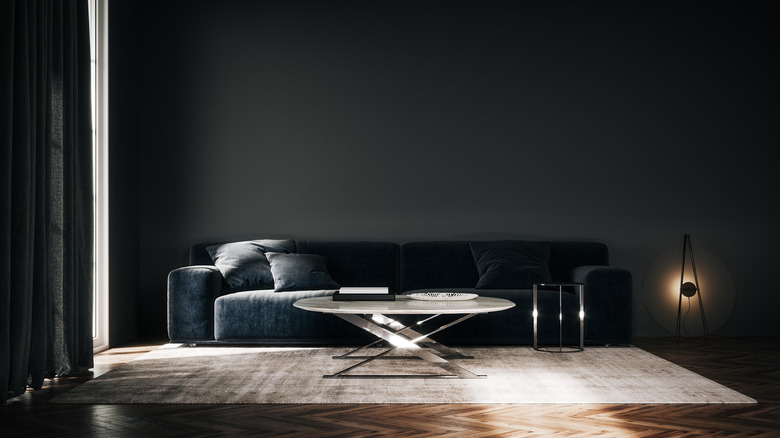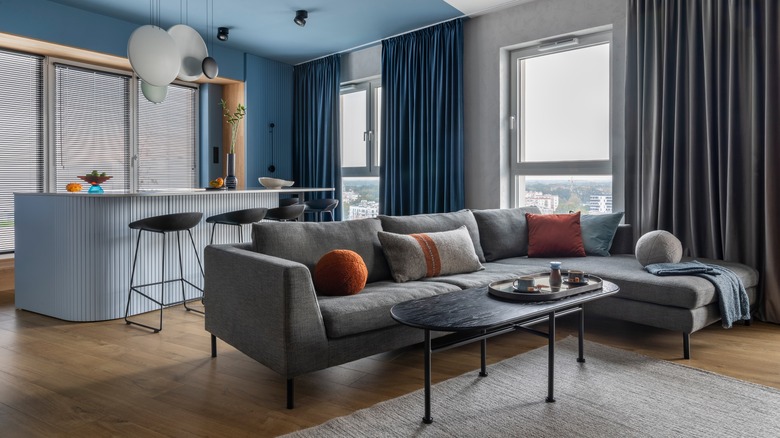Why Dark Curtains Might Not Be Your Bliss In A Living Room
In the modern age, we may no longer depend on sunlight and candles to keep our houses lit, but lamps and light fixtures are no substitute for the benefits of natural sunlight, especially in busy, social spaces like living rooms. Being in natural light has proven benefits for mental and physical health and can even lessen your risk of developing depression (via UCLA Health). While they might be great for bedrooms, dark curtains aren't usually a good choice for living rooms because they make the whole space feel darker, smaller, and dingier, dragging down the energy of this lively space.
Of course, everyone's personal taste is unique, and some people may like the idea of a dark and moody curtain moment. Why would curtain color matter so much in a living room? After all, isn't it a good thing to have a cozy and calming living room? Learn more about why interior designers say a dark-colored curtain can drag down the vibe and what you can do if you're determined to decorate on the dark side.
Dark curtains bring a stormy mood
While dark curtains can look stylish in some living rooms, they aren't the most flattering idea in the majority of cases. Most people want their living rooms to feel lively, and a dark curtain tends to drain the room's light and energy. Dark colors and blackout curtains are great for bedrooms because they signal to your brain that it's time to wind down and produce melatonin. However, placing them in a household gathering space can dampen the mood and sap your energy too much. Black curtains may be the moodiest offenders, but that doesn't mean other dark colors are much better. "Avoid navies and other dark blue shades in a room that does not get much natural light," interior designer Carlin van Noppen warned Better Homes and Gardens, "They can appear dominating and will make the space seem even darker."
So black and navy may not be good options, but what about browns, greens, and other dark neutrals? Interior designer Dustin Gerken still argues they aren't ideal. "This is a heavier color family that tends to do well in blackout situations where the hue's ability to soak up light is utilized without much effort," Gerken told Better Homes & Gardens, "Avoid placing this color [dark browns and greens] in a light-filled, stark room where the earthy, tectonic tone will be the heaviest visual in the space."
Making dark curtains work for your living room
In most situations, any deep, dark shades should be reserved for quiet spaces like bedrooms, dens, or reading rooms, but if you love the idea of dark curtains in your living room, there are some ways to make it work. When shopping for your curtains, look for a lightweight, sheer, or semi-sheer fabric like linen. Even though the color may be dark, the delicate fabric will allow some sunlight to twinkle through, ensuring that the overall vibe of the space stays positive. You'll generally want to avoid chunky, thick fabrics like velvet or brocade, which can feel extra heavy in dark shades. You can also choose a dark curtain with a print to inject a little more energy.
Next, make sure that the curtain will work cohesively in the space. "Avoid using curtain colors that clash with the furniture or decor in the living room." Interior designer Jennifer Davis said (via Better Homes and Gardens), "Choose hues that harmonize with the existing living room color scheme, creating a cohesive and visually pleasing atmosphere." For example, if your living room already has some blue elements, a dark navy curtain won't seem so out of place. Finally, draw back the curtains whenever possible to allow sunlight into the room. Using a slightly oversized curtain rod will ensure that there's plenty of space to slide the curtain away and reveal the full window.


